What Are Cocktails On Tap & How Will They Make My Business More Money?
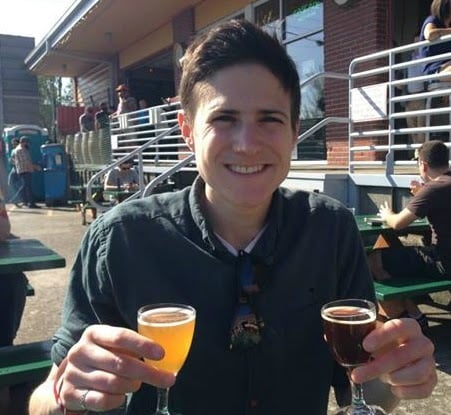
July 15, 2021
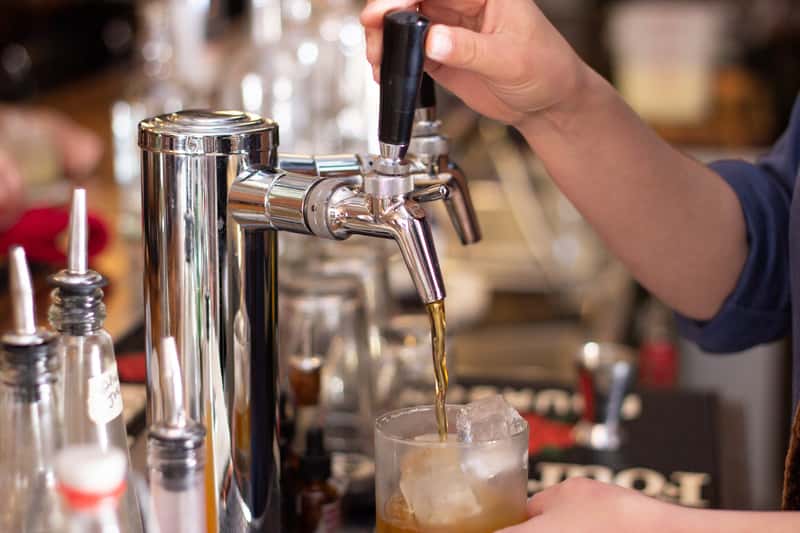
Last year, the global COVID-19 pandemic forced many bars, restaurants, taprooms, and breweries to shut down, changing the industry and drinking culture completely. As consumers were forced to drink at home, businesses turned to various strategies to keep the revenue flowing. One of these was serving batch cocktails to go.
According to a Bacardi Limited 2021 annual Cocktail Trends Report with external research commissioned by Nielsen CGA, ready-to-drink beverages such as canned cocktails grew 131 percent in the U.S. market.
Now, as people start safely returning to their barstools, they’re looking for more creative and experimental ways to consume their mixed drinks. Cocktails on tap are an innovative way to serve hard beverages -- and they have a huge amount of benefits. From being more efficient than regular cocktails, to requiring fewer employees to serve, lowering operational costs, and increasing profits, cocktails on tap are a smart, viable strategy for any bar, restaurant, brewery, or taproom, especially as businesses across the country continue reopening.
What We’ll Cover in This Piece:
- What Are Cocktails on Tap?
- What Are the Advantages of Serving Cocktails on Tap?
- Four Important Considerations For Draft Cocktails
- What Equipment Do You Need to Get Started?
- What Are Some Examples of the Best Cocktails to Serve on Tap?
- Which Cocktails Should You Avoid?
- What Is the Future of Cocktails on Tap?
What Are Cocktails on Tap?

Similar to draft beer, cocktails on tap are homemade alcoholic mixtures that are stored in a vessel known as a Cornelius (Corny) keg and hooked up to a draft line.
“Cocktails on tap are just cocktails that come out of a draft system,” says Cat Cannon, Chief Operating Officer at Mindful Hospitality Group, a bar consulting, education, and events company that specializes in helping bars elevate their cocktail menus along with hiring staff and providing education and training. Cannon also opened her own bar, St. Clair Social, in Pittsburgh, Pennsylvania, last August during the pandemic.
Just as beer on draft is already made and ready to go, cocktails on tap are prepared ahead of time in larger batches, stored in a keg, and accessed on tap by a bartender when the time comes to pour.
It’s this accessibility, ease of service, and consistency that have made cocktails on tap extremely popular.
What Are the Advantages of Serving Cocktails on Tap?
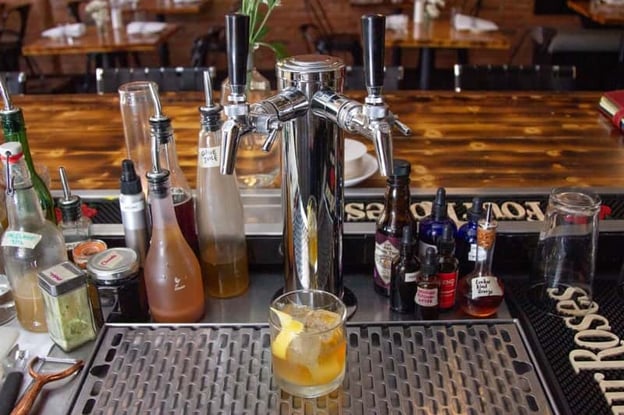
Speed, consistency, increased revenue, and ease-of-marketing are a few of the biggest advantages to serving cocktails on tap.
Speed
The traditional way of making cocktails requires one bartender to employ various techniques as they blend together different liquors, juices, fruits, spices, and more. While there is certainly an art to this practice, it also takes time and careful attention. With pre-batched cocktails served on tap, a bartender simply needs to fill up a glass from the draft line at the point of service. No shaking or stirring required.
“Speed behind a bar is essential, especially right now when there’s a huge staffing crisis across the country,” says Cannon. “You have less people on staff at one time, but [your consumers] are raring to go, so you’re taking care of people all the time. With [cocktails on tap] you do all the prep on the backend, so bartenders just have to pour and go. The faster you get drinks in peoples’ hands, the more money is on the table. The quicker people drink, the more they’ll drink, and the happier they’ll be. It’s a win-win-win for everybody.”
For Chris Universal, the Draft Beverage Manager at KegWorks, a company with twenty-three years of experience providing commercial and residential customers with all the things they need to pour beer and cocktails, the biggest advantage to leveraging cocktails on tap is speed.
“With faster service you can sell more drinks. And more drinks sold means happier customers who aren’t waiting as long,” says Universal.
Not only do cocktails on tap speed up service, but they’re also an easy way to make a consistent drink.
Consistency
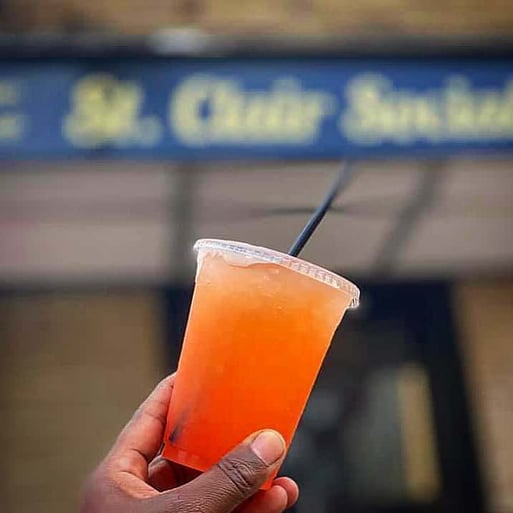
For ten years, Chris Universal bartended in Buffalo, New York, and noticed every single bartender he worked with made the same cocktail recipe a bit differently. Everyone had their own touch on how they liked to make it. That “fingerprint flourish” is part of what makes cocktails unique.
However, in a high-volume setting that approach might not make sense. Especially for crowded venues like nightclubs, concert halls, taprooms, and bars, quality control is essential. Serving cocktails on tap ensures the perfect pour each time from bartender to bartender, whether they’re just a newbie learning the ropes or a seasoned professional.
Cannon agrees. “If I do cocktails on draft, I won’t have to worry about my bartender getting the recipe right every single time,” she says. “I can take care of [the product] on the backend so no matter what, [my bartender] is successful and the customer gets a consistent product.” It’s a surefire way to serve the same quality drink to each and every one of your consumers.
More Revenue
Quality, consistency, and speed are a bar owner's trifecta, typically contributing to a better bottom line. Time is money! If you can more efficiently make a cocktail in a shorter amount of time, that means more people are spending money at your establishment.
“[Serving cocktails] on tap means your bartender and waitstaff move faster, which means you’re generating more revenue because you’re reducing the amount of time it takes for the cocktail to make it to a table,” says Jake Sinkler, Director of Marketing at Oktober Can Seamers, a Grand Rapids-based company producing a line of compact, sturdy, and easy-to-use individual can seamer machines that can be used to seal everything from to-go cocktails to beer crowlers.
Catchy Marketing
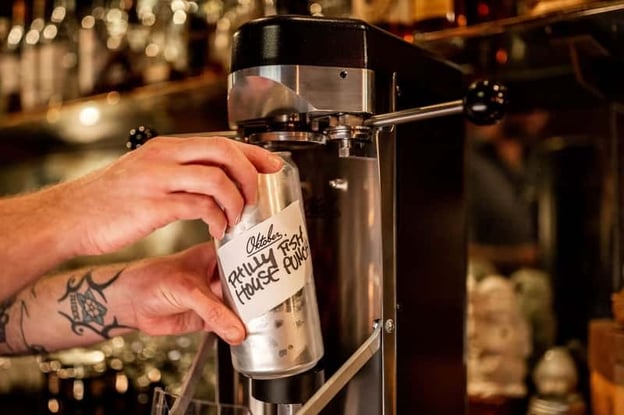
Optically, consumers are drawn to cocktails on draft.
“People just love it,” says Cannon, who notes when people come into her bar and see one of the four cocktails they have on draft right now—an Old Fashioned, Boulevardier, Espresso Martini, and Long Island Iced Tea—they almost always say, “Oh my god, that’s on draft? I want that!”
“It’s a unique way to serve cocktails,” says Cannon. “I would argue draft cocktails right now are just as hot as frozen cocktails.”
The benefits to leveraging cocktails on tap are clear. But, if you’re catching on to draft cocktails, there are a few considerations to keep in mind before diving in.
Four Important Considerations For Draft Cocktails
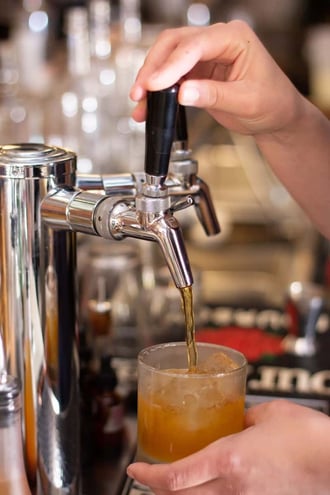
For all their ease, cocktails on draft aren’t a “set-it-and-forget-it” offering. Here are a few important tips to keep in mind:
Carbonation / Temperature
For most draft beer systems, a certain amount of CO2 is introduced into the lines to actually “force” the beer up and out of your tap handle. The science doesn’t quite translate to draft cocktails and it can sometimes be very daunting to find the right pressure (commonly measured as PSI) for dispensing your cocktail.
Insider Tip: To avoid this, either have a professional like KegWorks install your system and work with you to find the right PSI setting for your cocktail on draft, or create a draft cocktail menu with recipes that work well with carbonation.
Cannon, who is currently consulting for a company called Tipple Taps, designed each of the mobile bar’s four cocktail recipes to include carbonation. The Moscow Mule, Paloma, Gold Rush, and Old Cuban variations all have a sparkling element to them, so the normal carbonation makes sense. Just keep in mind that if you go for fizzy cocktails, they should be served at 38 degrees Fahrenheit to keep the carbon dioxide in suspension.
Dilution
With bespoke cocktail-making, stirring or shaking is an important part of the process because it chills and dilutes the final drink. Achieving the right amount of agitation for each cocktail recipe is an art unto itself, and most bartenders simply hone their skills through practice and taste.
If you’re serving a cocktail on tap, you can’t control this quite as easily. Instead, you’ll need to dilute the cocktail during your prep time.
“If you’re making a Manhattan, when you mix it in a glass, there’s ice in there that dilutes the drink and affects the taste and ABV tremendously,” says Universal. “However, if you prepare that cocktail ahead of time, it is not quite the same as mixing it in a glass.”
Dilution levels vary based on the cocktail type, ingredients, amount you're making, and other factors, so Universal suggests spending a good amount of time testing your recipe through trial and error to get it right.
Insider Tip: To figure out that perfect level of dilution, Cannon recommends using a site like Cocktailcalc.com that will do all the math for you. You just need to input the ingredients from the recipe, size of your batch, and what kind of cocktail it is, and the calculator will pop out the best dilution measurements.
Agitation
Pre-batched cocktails will spend a fair amount of time sitting around in a keg. So certain ingredients -- such as a heavy dose of sugar or syrup -- will eventually settle to the bottom.
From a consumer perspective, as a bartender works their way through the keg, a pull earlier in the shift could be perfect, but later in the night might turn out sweeter or boozier if all the sugar or syrup has fallen to the bottom of the batched beverage.
“That’s one of the more common questions I get,” says Universal. “‘If I’m doing something with a lot of sugar, will it separate out?’ The answer is yes, over time. But if you take the keg, pick it up with your hands, and give it a little shake once or twice a day you should be fine.”
At a minimum, Universal suggests having your bartenders do this at the beginning of each shift.
Clean Your Lines!
If you’re already serving draft beer, then you know that regularly cleaning your lines is incredibly important. The same goes for draft cocktails. In fact, it's even more imperative.
“Natural ingredients [in a cocktail] can affect lines in a lot of ways, so you need to keep them as clean as possible,” says Cannon. “You don’t want erosion or weird things growing in your lines. Just clean them and take care of them!”
If you’re able to follow these few particulars, it might be time to start gathering the furnishings you’ll need to pull off your new cocktails on draft.
What Equipment Do You Need to Get Started?
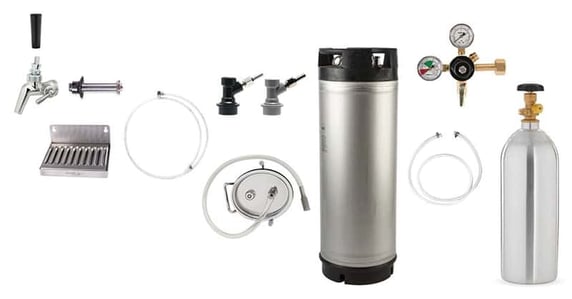
Chances are, you’re thinking that if you already have a bunch of taplines running for your draft beer, you can simply pop a keg of batched cocktails on and call it a day.
Not true! Setting up draft cocktails requires a bit more time and attention.
“Honestly, I would recommend starting with your own independent system to test this out in whatever environment you're in,” says Universal. “Some people want to put their cocktails right into their beer system, and it’s just not a good idea because… cocktails can damage the equipment and stain it as well. If you don’t use the right lines, cocktails can dive into them and be very difficult to get the taste out of if you want to switch back.”
According to Universal, there are two ways to build a great draft cocktail system.
- Direct Draw System
Sets up your keg right underneath or nearby your dispensing system. Since your batched cocktail will only travel a short distance, it won’t need any special insulated or temp-controlled lines. - Long draw or Remote System
Means your kegs can be up to 300 ft away from your dispenser. This system will require air-cooled or glycol-cooled lines to keep everything cold as it moves from keg to tap handle. It’s a more elaborate system that can potentially be pricier but might be more effective for you depending on the space and shape of your bar.
Beyond those considerations, KegWorks suggests starting with these standard pieces of equipment. Of course, the exact gear you’ll need will depend on whether you’d like to serve fizzy or unfizzy cocktails, but here’s a general list of what you’ll need:
- Cornelius keg (used or new)
- Two Cornelius Ball Lock Style Quick Disconnects - Gas & Liquid
- Nitrogen tank and regulator (if serving still cocktails)
- CO2 tank and regulator (if serving carbonated cocktails)
- Air line
- Barrier tubing
- Draft tower with all stainless steel contacts (including shank and faucet)
- If you are carbonating at a pressure of 40 PSI or higher, a Perlick flow-control faucet and inline flow restrictor are also necessary
If you take away nothing else from the above list, keep these two considerations in mind:
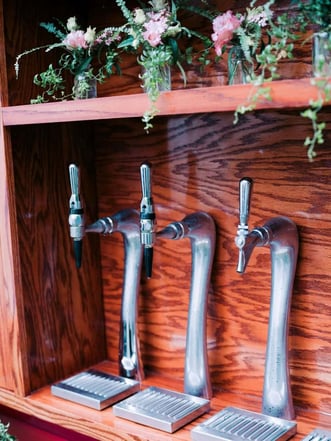
- Stainless Steel
For anything touching a beverage, it’s imperative to use stainless steel components. The other option, called Chrome Plated Brass, looks pretty, but has a tendency to erode when it reacts with the acidity of liquor. Eventually, those juices will strip away that chrome and you’ll find small pieces of it in your customers’ drinks. In addition to being unsanitary, it’ll affect the texture of your beverage.
“It’ll create more of a sandpaper style that the beverage is running over which is not what you want. You want your cocktail to be as smooth and nonporous as possible,” says Universal. - Barrier Tubing
This is a very stiff and rigid type of plastic tubing that is resistant to flavor stain. This type of material works best with cocktails.
All in all, if you’re starting from scratch, Universal says that to install everything you’ll need to serve two cocktail taps will probably run you in the $1,500 range. The price gets more expensive the further the kegs are from the dispenser because there’s more equipment involved with keeping those beverages cold.
If this sounds a little daunting, then follow Cannon’s advice: The best move here is to bring in the professionals. “The biggest struggle [with cocktails on tap] can be kegs and tap systems because they are a science and technology… it’s easy to make a mistake and put the out line in the in line and then you’re screwed,” says Cannon. “Work with a draft tech pro to make sure you do everything right. It’s better that you have all the information because if something gets screwed up you can be left with 640 ounces of a corny keg of product just sitting there that will go down the drain. And you can’t make money on it.”
What Are Some Examples of the Best Cocktails to Serve on Tap?
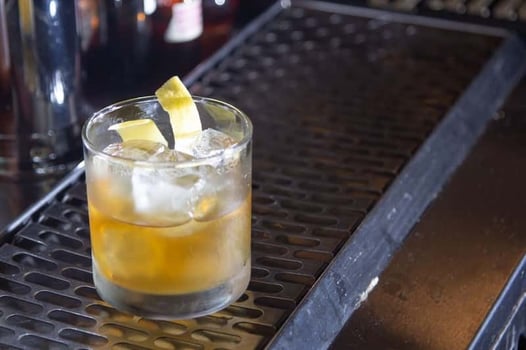
Now comes the fun part. If you have all the right equipment, you can start planning your menu. Classic recipes perform best on draft because they’re accessible. Plus, they usually feature simple, standard components.
“You don’t want to put on some cocktail that has a super weird ingredient or one you’re unfamiliar with because you could spend a lot of money bringing in that product in large quantities and it might just sit in a keg not moving,” says Cannon. “I would recommend looking at classic cocktails and using those as basic algorithms and then doing a little twist on it.”
Things like Manhattan, Negroni, and Paloma all work well on draft.
Sinkler has even seen some of his customers batching French 75s or straight-up Fernet and Green Chartreuse.
“[These cocktails are] widely known,” says Universal. “A lot of people drink them so it’s something people think sounds good. Technically, they’re not carbonated so you don’t have to worry about the bartender under or over carbonating them, and they’re all spirit based so they have a longer shelf life. If you’re getting into something with fresh squeezed juices or syrups, the mixture could tend to deteriorate over time.”
Which Cocktails Should You Avoid?
Anything with perishable ingredients should probably be avoided on draft. Because your pre-batched cocktail will be sitting in a keg for an extended period of time, it’s harder to control the cocktail’s shelf life with components that expire.
Similarly, fresh juices or anything with pulp or spices will be more likely to clog the draft lines, inviting mold growth or proliferation of bacteria. That means avoiding things like sangria and certainly anything with egg white. That’s just asking for a headache!
If you’re going to use fresh ingredients, make sure you’re only making enough for a batch to last a couple of days.
Insider Tip: Make a shelf-stable acid solution. To avoid the concern of a spoiled batch, Cannon uses citric acid, sugar, and water to create the presence of lemon juice without the actual fresh lemon.
For the best results, stick to those spirit-forward recipes that get better over time like the aforementioned Manhattans and Negronis.
What Is the Future of Cocktails on Tap?
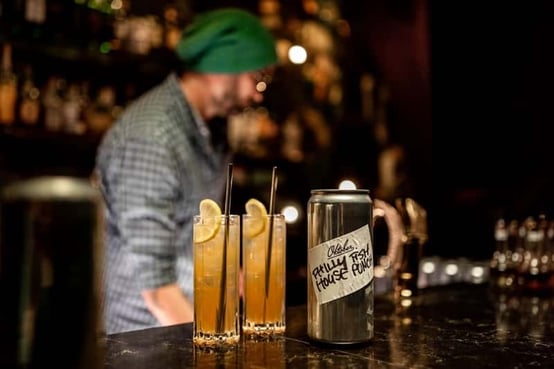
During the global COVID-19 pandemic, cocktails on a draft system became an easy way for business owners to batch, dispense, and serve cocktails to go. Solutions like these helped drive revenue amid city lockdowns.
As places open back up, consider using your draft system to continue serving cocktails to go (as long as it’s still legal in your area).
“From a to-go perspective, canned cocktails are a super viable revenue source for any bar, restaurant, and brewery,” says Sinkler. “If you’re reducing costs and putting something that costs a fair amount to customers in cans and selling them to go, it's a great opportunity for any business to make more money.”
Cannon agrees that despite a traumatizing and stressful year, it has been a great time for invention and growth in the hospitality community. And creativity with cocktails, whether being served on draft or to go, will continue to drive the industry forward.
“We’ll start to see the trend show up more and more as we move forward because, if we’re at a point where we can have a high-quality cocktail on tap that's cold and ready to serve, it’s a good way for bars and restaurants to make money quickly and reduce costs,” says Sinkler. “As long as it can be done right and replicated, I think that we’ll continue to see growth.”
Now is the time to tap into cocktails on tap!
Unlock Your Beer and Beverage Potential!
More than 20,000 venues around the world use Untappd for Business for menus, analytics, and promotion of their venue.
Schedule a demo or start your 7 day free trial – no credit card required.
